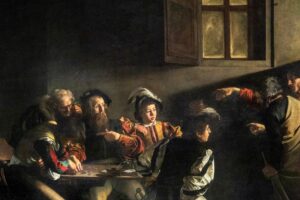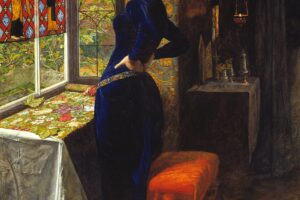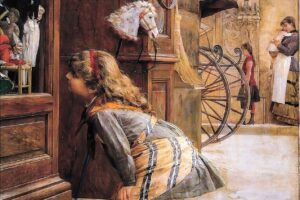The Republic at Home
Portrait of André-François Miot, Envoy of the French Republic to the Grand Duke of Tuscany – Louis Gauffier, 1796 – Neoclassicism
Painted during the turbulent rise of the French Republic, this neoclassical portrait by Louis Gauffier offers more than a likeness—it is a visual manifesto. Beneath the polished marble floors and family tenderness lies a deeper message: the new ideals of liberty, virtue, and civic duty are not just public, but personal.
Completed in 1796, this painting captures André-François Miot, the French envoy to Tuscany, with his wife and children in Florence. With poised formality and intimate detail, Gauffier blends private affection with public symbolism, giving us a striking window into the values of post-revolutionary France.
The Scene Before Us
Miot stands draped in a republican red cloak, his pose relaxed but dignified. He leans slightly, not toward his family, but toward the bust of a Roman-like figure marked “J.B.” (likely representing Jean-Baptiste or the ideals of republican virtue), beside which rests a bonnet rouge—the revolutionary red cap. Behind him, a sweeping view of Florence roots the scene in its diplomatic setting.
At the heart of the composition sits Miot’s wife, regal in white, her baby perched calmly on her lap. A little girl tugs gently at her arm, seeking attention. Beside them, a man (likely a tutor or guardian figure) offers the infant his hand, a symbol of guidance and the continuity of learning.
To the far left, a green statue of Liberty—or Minerva, goddess of wisdom—presides over the family, bearing the words République Française. All around are echoes of Rome: architecture, clothing folds, classical busts. But the emotions are of a family bound by affection, not myth.
The Deeper Meaning
This painting walks a careful line between personal and political. Miot’s central but detached stance reflects his role as a diplomat: representing France abroad, but also upholding her revolutionary virtues at home.
The inclusion of family softens what could have been a rigid state portrait. Here, the Republic is not only a battlefield or assembly hall—it’s a domestic philosophy. The neoclassical style reinforces this vision: order, clarity, symmetry, and timeless dignity. Gauffier’s brush renders every marble tile, gold accent, and facial expression with lucid precision.
More than a record of a diplomatic career, this is a reflection of how post-revolutionary France wanted to see itself: rational, virtuous, cultivated, and familial.
A Moment Caught in Time
As Europe struggled with war and shifting power, Louis Gauffier—himself a French artist in exile—painted a calm world that felt steady and just. Florence’s skyline in the background may hint at diplomacy, but it is the figures in the foreground who embody his message.
This is not simply a portrait of a man in service to the Republic—it is the Republic rendered as a family. Stoic, loving, enlightened. The child’s small hand in the tutor’s—this is the future being taught. The wife’s calm gaze—this is liberty anchored in gentleness. And Miot, watchful and composed—this is the citizen turned statesman.
About Artist

Louis Gauffier (1762–1801) was a French painter of the Neoclassical period. A student of his older brother, Henri Gauffier, and a protégé of the renowned Jacques-Louis David, he was known for his elegant portraits and historical scenes. Gauffier spent a significant portion of his career in Italy, particularly in Rome and Florence, where he was heavily influenced by classical sculpture and Renaissance art. His work is characterized by its refined drawing, clear composition, and a more delicate, less severe style than his mentor David.
Artistic Style and Legacy
Gauffier’s style reflects the core principles of Neoclassicism, but with a personal touch. His art is distinguished by:
- Purity of Line: Like other Neoclassical artists, he placed great importance on the precision of his lines and the sculptural quality of his figures.
- Refined Realism: His portraits, in particular, are celebrated for their meticulous detail and their ability to capture the dignity and character of his sitters without the rigid formality seen in some of his contemporaries.
- Classical Allusions: He often incorporated elements from classical antiquity, such as sculptures or ruins, into his portraits and landscapes, grounding his work in the traditions of the past.
Despite his promising career, Gauffier died young in Italy, which limited his overall output and contributed to his work being less widely known than that of David or Ingres.
Notable Works
- Portrait of Count Gustaf Mauritz Armfelt (1790s): This painting is a beautiful example of Gauffier’s refined portraiture. It depicts a Swedish statesman and diplomat in an elegant pose, with a sense of both dignity and approachability.
- Portrait of André-François Miot (1790s): This work is another testament to his skill in capturing the character of his subjects. The portrait of the French diplomat and writer is known for its sense of quiet intellect and elegant composition.



